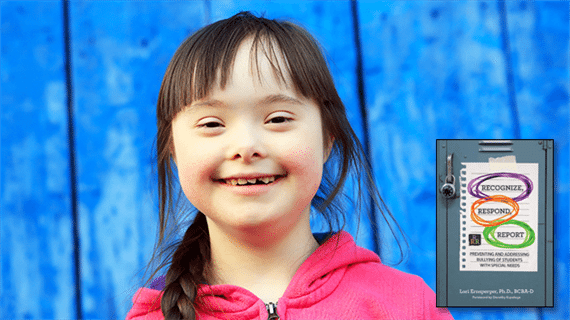It breaks your heart to witness it. Your student, who has a learning disability, sits down next to two classmates in the cafeteria. The duo roll their eyes and sneer. “Look, it’s the slow kid,” one says. When you catch up to them, they shrug. “We were just joking around,” they say.
Bullying is a problem for all sorts of kids. A National Center for Education Statistics survey recently found that one in four elementary and secondary students report being bullied each week, and 7 percent say they are bullied every day.
But zoom in on students with disabilities and it’s ubiquitous. Sixty percent of students with disabilities are bullied in school, according to AbilityPath. And, students with disabilities are often socially excluded or isolated, making them targets for bullying.
Bullying is any unwanted behavior that hurts someone else. It often involves an imbalance of power. Just because there wasn’t intent, or the bully says he “was just joking around,” doesn’t mean that it’s not bullying. If any child feels intimidated or hurt in any way, it’s bullying.
At the same time, it’s important to note that not all childhood conflict is bullying. Rough play, arguments and conflict do not necessarily comprise bullying. Any time that both children are quick to apologize and move on, it’s not bullying.
Students with disabilities (in this case, students who receive services through an IEP) are more likely to be bullied. As their teacher, you’re often the first line of defense. Here are nine ways to combat the bullying of students with disabilities in your classroom, from creating a positive classroom culture to planning lessons that build student social and emotional skills.
Classroom Culture Counts
1. Analyze your words.
It’s not intentional, but you may talk to students who have ADHD or learning disabilities differently than other students. For example, making sarcastic comments when Sam has misplaced his pencil for the millionth time. This is problematic because when kids see adults treating certain kids differently, they think it’s OK for them to do the same. Pay close attention to how you speak to students to be sure you’re modeling the communication you want to see from your students.
2. Supervise hot spots.
We know that bullying is more likely to occur when teachers aren’t watching. Figure out your school’s “hot spots” for bullying—the places with less supervision and more kids. To start, ask custodians, office assistants, cafeteria workers and bus drivers where they see problems.
3. Make class meetings routine.
Even a quick, 10-minute class meeting allows students time to talk about things that are important to them and address concerns that arise. Allow students to take a leadership role by planning the meeting, but be ready to help them solve problems and stay on topic. (Here are tips on leading class meetings.)
4. Build a positive classroom climate.
A positive class climate is predictable, consistent and equitable. Take time at the start and throughout the year to model problem solving and communication. And go out of your way to recognize each student for his or her unique strengths and talents. (Read these tips for building a positive classroom climate.)
Create Upstanders, Not Bystanders
5. Teach tolerance.
Here’s where an ounce of prevention comes into play. Teaching kids self-awareness and empathy can go a long way to preventing bullying. Both can be built using literature:
To teach self-awareness, review multiple sides of a conflict in a story or scenario. Books like The True Story of the Three Little Pigs by Jon Scieszka or The Day the Crayons Quit by Drew Daywalt are a good start.
Literature with protagonists that have disabilities, like Joey Pigza Swallowed the Key by Jack Gantos, Mockingbird by Kathryn Erskine and Wonder by R.J. Palacio, are wonderful for building students’ awareness of specific disabilities. These stories also build empathy that transfers into real-world scenarios. (Here are elementary and upper-grade lists of books that feature characters with disabilities.)
6. Teach kids to be “upstanders.”
Students need to know that when they don’t stop someone from bullying, they’re contributing to it. Teach kids to be upstanders by showing them how to quickly recognize bullying and basic techniques to stop it—like not creating an audience, or inviting the victim into their group, for example. (Find more tips to teach upstanding at Stomp Out Bullying.)
7. Build self-advocacy.
On the other hand, teach students who have disabilities how to advocate for themselves. Help students who struggle with social skills to recognize when someone is being hurtful, and give them language to use to help them respond.
8. Share experiences through multimedia.
Challenge students to create multimedia projects that express their thoughts, opinions and personal experiences with bullying. The technology encourages creativity and individualism, and the ability to share their experiences builds students’ communication and advocacy.
9. Stop-talk-walk.
If you come across a bullying incident, stop the incident immediately using a clear, firm tone. Tell the students what you saw: “I saw Sarah calling Nancy rude names.” And tell them the school policy they broke: “In our school we don’t use language that’s hurtful.” Don’t accuse them (“I know you did this.”) or ask questions (“Are you saying you didn’t call him a name?”). Then, move the students to another location to follow up and help the pair through conflict resolution.
Keeping students with disabilities safe from bullying is about more than avoiding conflict: It’s the first step toward creating the community they’ll live in in the future. So take steps now to cultivate a caring, responsive community, starting in your classroom.
Recognize, Respond, Report: Preventing and Addressing Bullying of Students With Special Needs is available now.
Dr. Lori Ernsperger received her doctorate in Special Education from Indiana University. She has over 25 years of experience working in the public schools as a classroom teacher, administrator and behavioral consultant. Dr. Ernsperger is also the author of Keys to Success for Teaching Students With Autism and Girls Under the Umbrella of Autism Spectrum Disorders.

